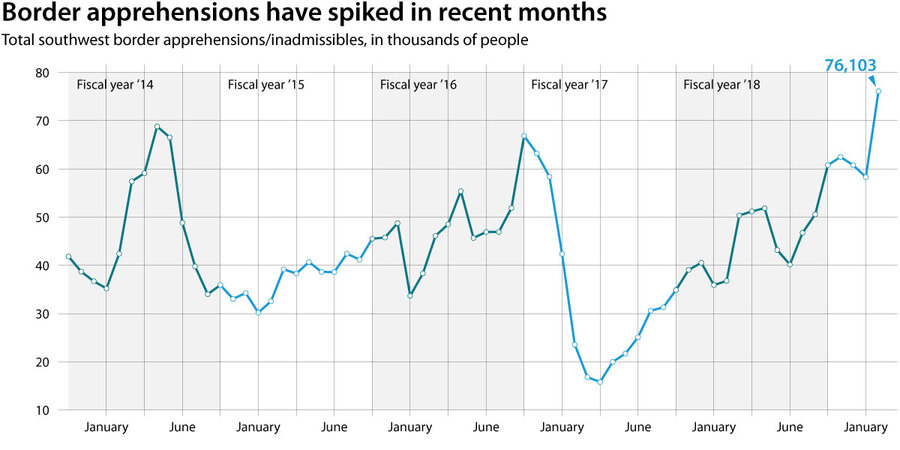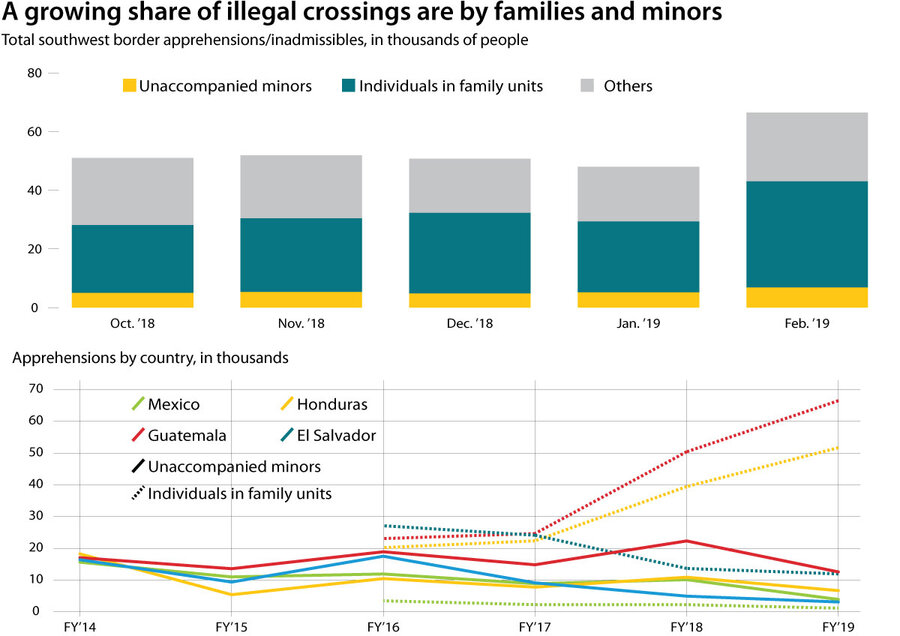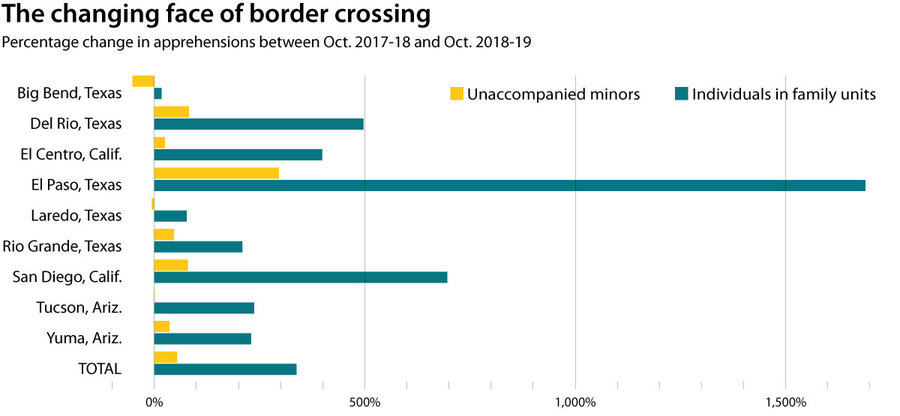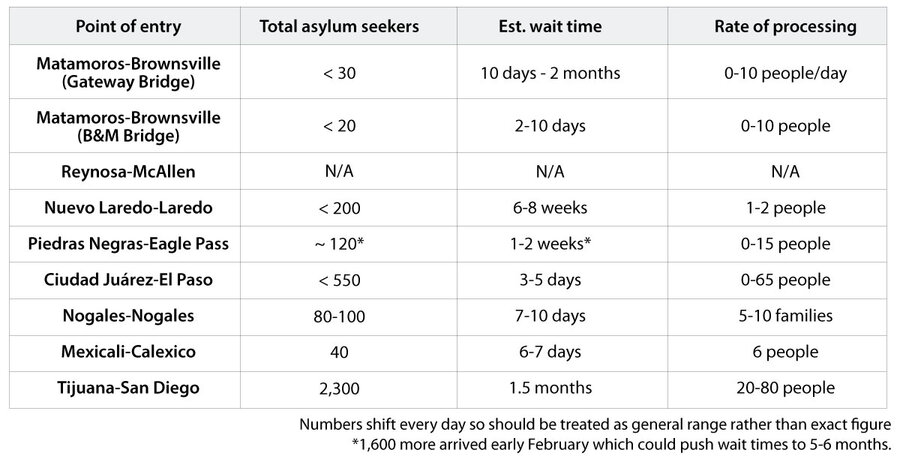Is there a border crisis? Depends on how you measure it.
Loading...
| Austin, Texas
The crisis on the U.S.-Mexico border is real, Homeland Security Secretary Kirstjen Nielsen told a House committee earlier this month.
Between October and the end of March, U.S. Customs and Border Protection is on track to apprehend more migrants entering the country illegally than during the entire 2017 fiscal year, she said, adding, “Our capacity is already severely restrained, but these increases will overwhelm the system entirely.”
Why We Wrote This
There’s no shortage of statistics being tossed around about migration along the U.S. southern border. We thought we’d share some charts so you can make up your own mind about what’s happening.
Her statements came amid a widespread questioning of President Donald Trump’s declaration of a national emergency at the southern border last month. The president has been transparent that the declaration is a way to go around Congress to secure funding for a border wall, a signature campaign promise, that the legislature denied. Congress voted to end the emergency – with some critics claiming there is no crisis by pointing out that apprehensions are near historic lows – but Mr. Trump overruled it with the first veto of his term.
So is there a crisis on the southern border?
The crisis on the United States-Mexico border is real, not manufactured, Homeland Security Secretary Kirstjen Nielsen told a House committee earlier this month. The crisis is “real, serious, and sustained,” she told lawmakers, and likely to get worse as the weather warms up.
Between October and the end of March, U.S. Customs and Border Protection (CBP) is on track to apprehend more migrants entering the country illegally than during the entire 2017 fiscal year, she said, adding, “Our capacity is already severely restrained, but these increases will overwhelm the system entirely.”
Her statements came amid a widespread questioning of President Donald Trump’s declaration of a national emergency at the southern border last month. The president has been transparent that the declaration is a way to go around Congress to secure funding for a border wall, a signature campaign promise, that the legislature denied. Congress voted to end the emergency – with some critics claiming there is no crisis by pointing out that apprehensions are near historic lows – but Mr. Trump overruled it with the first veto of his term.
Why We Wrote This
There’s no shortage of statistics being tossed around about migration along the U.S. southern border. We thought we’d share some charts so you can make up your own mind about what’s happening.
So is there a crisis on the southern border?
The numbers do show a surge in apprehensions in recent months:
But a look further back reveals that apprehensions at the southwest border have been near historic lows for years:
Who is making the crossing, and where?
While the volume may be lower, however, one reason agencies are struggling to cope now is a shift in who’s crossing.
For years most of those crossing illegally were adult Mexican men who were looking to work and who could be quickly deported once caught. Now the majority of those crossing are families and children from Central America seeking asylum and voluntarily turning themselves in to officials. The past five months saw the record for families detained between ports of entry broken four times, according to officials. Last month was the first time that families and unaccompanied children made up two-thirds of all apprehensions between ports of entry.
The problem for officials is that asylum-seekers, especially when they’re families and children, are much more complicated to process than single adults caught crossing illegally. Whether someone crosses illegally or not, their asylum claim has to be adjudicated – first by border officials, then by an immigration judge – which can take years given the mounting backlog in immigration courts. Families and unaccompanied children are also supposed to be held in special facilities, and by law can’t be held for more than 20 days.
“This past year, CBP experienced a 121 percent increase in the number of asylum seekers we processed at our ports of entry, and overall CBP processed almost 93,000 claims of fear in fiscal year 2018. CBP processes undocumented persons as expeditiously as possible without negating the agency’s overall mission, or compromising the safety of individuals within our custody,” a CBP spokesman said in an email.
The Trump administration has implemented various policies to deter this flow – families have been separated under a “zero tolerance” policy, the qualifications for an asylum claim have been narrowed, and migrants are now being returned to Mexico to await court hearings in the U.S., for example. The legality of that latter practice is being challenged in federal court on Friday. It also has alleged that many families seeking asylum are not biologically related.
During the first five months of 2018, the Department of Homeland Security found 191 cases of individuals using minors to pose as family units, out of 31,102 families apprehended. That was up from 46 cases of fraud in fiscal year 2017, according to The Washington Post.
The immigration system is not built to handle migrants of this type coming in these numbers, the administration argues in making its case. Complicating matters further, illegal crossings have surged in some areas of the border but not others:
Is the government responsible for the increase in migrants crossing illegally?
One policy in particular, advocates for migrants say, explains the recent surge in illegal crossings and bolsters their argument that the crisis is manufactured. “Metering,” which is having its legality questioned in court, limits the flow of asylum claims processed at official ports of entry.
Metering has been in place since 2016 in certain cities. Last summer CBP officials expanded the practice to ports of entry in every border state. Wait times at some southern ports of entry now stretch for months:
Such wait times are unheard of in the history of the U.S. asylum system, experts say. But the volume of asylum-seekers is also at record levels. CBP officers encountered 70 large groups, defined as 100 or more migrants traveling together, entering between the points of entry from October to February. Officers encountered 13 large groups in the same period last year, and only two the year before.
“When our ports of entry reach capacity, we have to manage the queues and individuals presenting without documents may need to wait in Mexico as CBP officers work to process those already within our facilities,” the CPB spokesman said.
Migrants have reported having to avoid security threats and pay bribes while waiting to enter a port of entry, and the long wait times have motivated asylum-seekers to cross illegally between ports of entry, immigrant advocates say.
A report from the Homeland Security Department’s inspector general confirmed this, and also noted that government officials had publicly encouraged asylum-seeking families to enter the country through ports of entry.
“However, at the same time, CBP was regulating the flow of asylum-seekers at ports of entry through ‘metering,’ ” the inspector general wrote. “A CBP official reported that the backlogs created by these competing directives likely resulted in additional illegal border crossings.”













